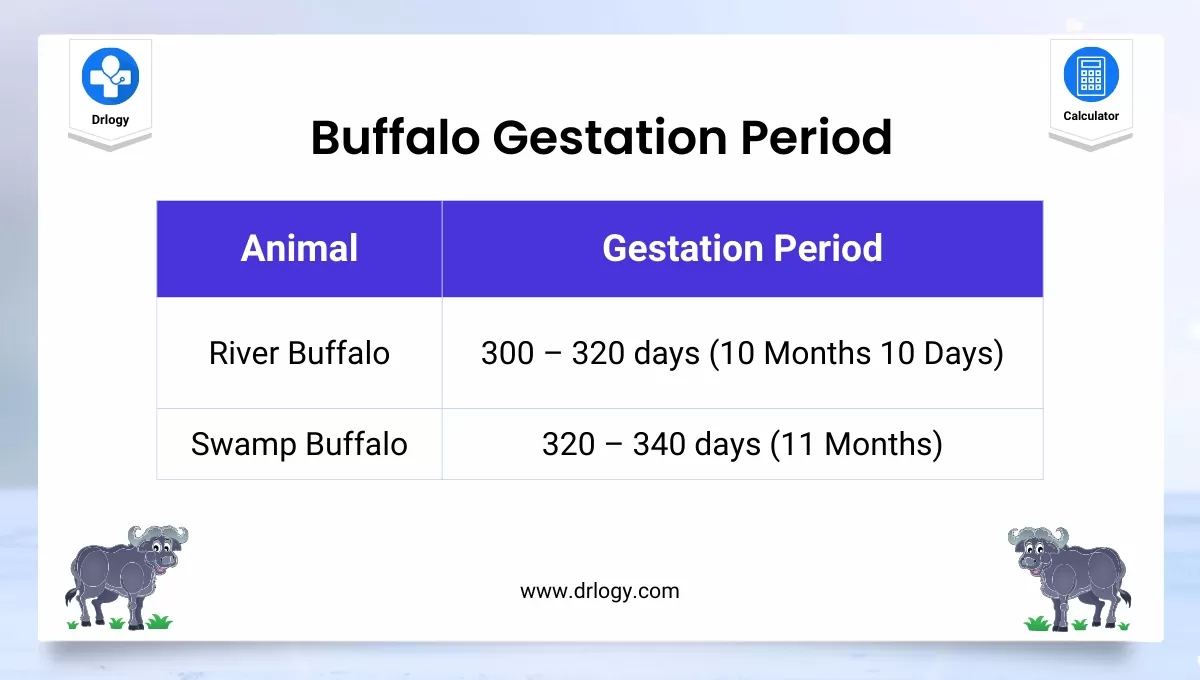Buffalo Gestation Calculator
- The Buffalo Gestation Calculator or Buffalo Pregnancy Calculator is easier to use than the Buffalo Gestation Chart.
- With the chart, you had to count the days until your Buffalo’s due date.
- Buffalo Gestation Calculator helps to answer the questions: ‘What is a Buffalo’s due date?’ or ‘How Long Are Buffalos Pregnant For?’ or ‘How Long is the gestation period for a Buffalo?’.
- It’s important that you enter the 1st day your Buffalo was bred for it to work properly.
Steps To Calculate Buffalo Pregnancy Due Date
- Enter the Serviced/Exposed Date
- Calculate Estimate Calving Date
- Calculate Min & Max Calving Date
Buffalo Pregnancy Calculator Formula
The Buffalo Pregnancy calculator uses the following formula:
Gestation date = Serviced/Exposed Date + 307 days
Buffalo Gestation Period
- The gestation period in buffalo is 280 – 334 days from the Serviced/Exposed Date.
- They have an average gestation period of 307 days.
| Buffalo |
Gestation Period |
| River Buffalo |
300 – 320 days (10 Months 10 Days) |
| Swamp Buffalo |
320 – 340 days (11 Months) |

Buffalo Gestation Chart
| Parameter |
River Buffalo |
| Sexual season |
Polyoestrous |
| Age at puberty (months) |
15–36 |
|
Oestrous cycle
|
| Length (days) |
18–22 |
| Oestrus (h) |
12–30 |
| Gestation length (days) |
300–320 |
| Age at first calving (months) |
36–56 |
| Calving intervals (months) |
15–21 |
Calculate Buffalo Pregnancy
Here are some parameters can help in calculating Buffalo pregnancy.
Gestation
- Gestation is longer in buffalo than cattle, varying from 300 to 320 days for the river buffalo and from 320 to 340 days for the swamp buffalo.
- Pregnancy is routinely diagnosed by rectal palpation of the uterus from about 40 to 45 days following insemination.
Parturition
- The birth process is similar to that of cattle
- The fetus is delivered in anterior presentation with fully extended limbs and fetal membranes are expelled 4–5 h later.
- Twinning is rare, and the incidence is less than 1 per 1000 births.
- Birth weights range from 26 to 35 kg with male calves weighing 2–3 kg more than female calves.
Postpartum Period
- After calving, the first oestrus and ovulation occur at about 60 and 90 days respectively in well-managed herds.
- Postpartum anoestrus or failure to resume estrous cycles after calving remains a major problem contributing to long calving intervals
Fertility
- Conception rates based on the nonreturn rates to AI are inaccurate, because of the inherent difficulty of detecting oestrus.
- Pregnancy rates, based on rectal palpation, usually range from 50% to 60% with chilled semen, 25% to 45% with frozen semen, and over 60% for hand matings.
- A buffalo usually produces, on average, two calves every 3 years.
- However, in well-managed herds, calving intervals of 14 to 15 months have been achieved.
Reproductive Management
- As mentioned previously, seasonal calving patterns in buffaloes have been attributed to ambient temperature, photoperiod, and feed supply.
- In India and Pakistan, buffaloes calving in summer or autumn resume ovarian cyclicity earlier than those calving in winter or spring.
- Perhaps decreasing day length and cooler ambient temperatures favor cyclicity.
- In the past, ‘silent oestrus’ – ovulation not preceded by oestrus – was believed to be a major problem in buffalo breeding but recent hormonal studies have revealed that it is due to the farmer's inability to detect oestrus.
Nutrition
- Similarly, early weaning, induction of oestrus with prostaglandin or intravaginal progesterone-releasing devices, and better nutrition have hastened the resumption of early postpartum ovarian activity and reduced the calving to conception intervals.
- Induction of oestrus with synthetic analogs of prostaglandin F2α and fixed-time insemination with frozen semen may prove useful in restricting mating seasons so that calving occurs when water and green feed are abundant.
- Male buffaloes show marked seasonal fluctuations in libido and semen quality, which may be overcome by providing cooling facilities during the hot season.
- In addition, females could be inseminated with semen collected and cryopreserved during the cooler months.
- Most reproductive management programs adopted for cattle can be effectively applied for the buffalo but commercial and smallholder farmers have not realized the benefits of such programs.
Feeding the Calf
- Two systems are practiced for rearing buffalo calves.
- In smallholder farms, calves are allowed to suckle their dams both for milk letdown and to suck 1–2 liter of milk. As they grow older, suckling time is gradually reduced and replaced by grass and small quantities of concentrate.
- Beyond 4–6 weeks of age, the calf is used only for milk letdown.
- In commercial farms, calves are weaned at birth and managed as for dairy calves
- Often male calves are neglected and die of starvation.
Summary
Overall Buffalo Gestation Calculator or Buffalo Pregnancy Due Date Calculator will give you the pregnancy date of your Buffalo. Check More Pet And Animal Related Calculators on Drlogy Calculator to get the exact solution for your questions.
Reference
- National Project for Cattle and Buffalo Breeding [1].
- Buffalo early pregnancy biomarker coding sequence cloning and partial length expression in E. coli after codon optimization [2].

